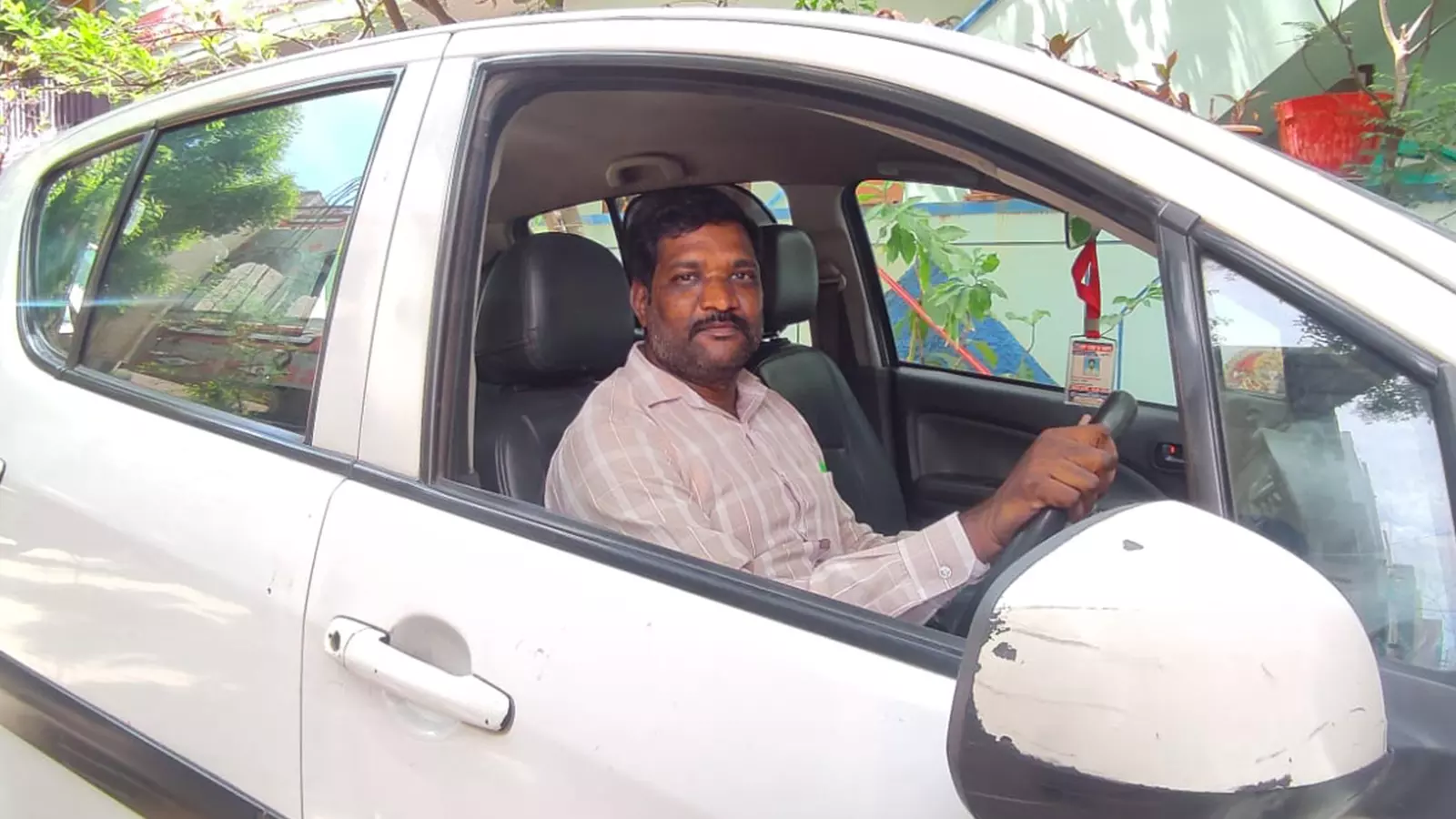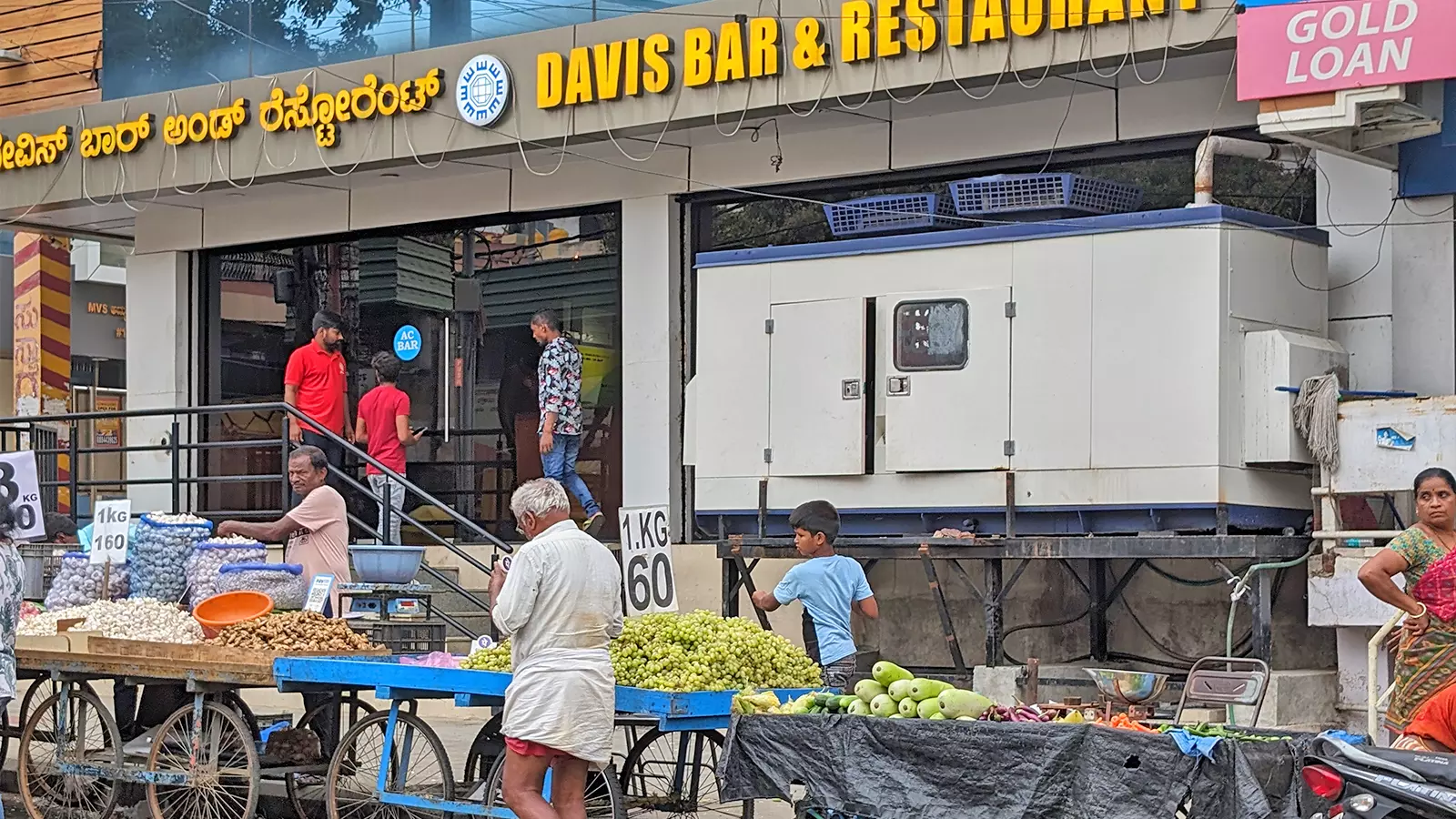
- Home
- India
- World
- Premium
- THE FEDERAL SPECIAL
- Analysis
- States
- Perspective
- Videos
- Sports
- Education
- Entertainment
- Elections
- Features
- Health
- Business
- Series
- In memoriam: Sheikh Mujibur Rahman
- Bishnoi's Men
- NEET TANGLE
- Economy Series
- Earth Day
- Kashmir’s Frozen Turbulence
- India@75
- The legend of Ramjanmabhoomi
- Liberalisation@30
- How to tame a dragon
- Celebrating biodiversity
- Farm Matters
- 50 days of solitude
- Bringing Migrants Home
- Budget 2020
- Jharkhand Votes
- The Federal Investigates
- The Federal Impact
- Vanishing Sand
- Gandhi @ 150
- Andhra Today
- Field report
- Operation Gulmarg
- Pandemic @1 Mn in India
- The Federal Year-End
- The Zero Year
- Science
- Brand studio
- Newsletter
- Elections 2024
- Events
As gig workers sweat it out, rising heatwaves spell trouble for economy

April 16 was a usual day for 41-year-old Santosh Kumar when he started taking rides on Uber at 8 am in Hyderabad. Despite being early morning, the sun was shining bright, and the heat rose as the day passed. Around noon, when the temperature was at its peak, Kumar drove to the airport to drop a passenger. He had been experiencing headache and had made several rounds to public toilets following...
April 16 was a usual day for 41-year-old Santosh Kumar when he started taking rides on Uber at 8 am in Hyderabad. Despite being early morning, the sun was shining bright, and the heat rose as the day passed. Around noon, when the temperature was at its peak, Kumar drove to the airport to drop a passenger. He had been experiencing headache and had made several rounds to public toilets following an upset stomach. While waiting for his next ride, Kumar’s head was throbbing and he felt pukish. When he got out of his car, he blacked out and fainted.
Other cab drivers rushed him to the nearest hospital for medical assistance.
“The doctor on duty declared I had suffered a heat stroke and needed to be admitted. The treatment cost was about Rs 15,000. I had to take a loan from my friends,” he said. “My bigger worry was the doctor’s advice of a 3-4 day rest. Taking rest meant losing out on my daily earnings. I have a family to feed and a car loan to pay so rest is not an option for me,” he told The Federal.
To earn about Rs 800-1,200 a day, 41-year old Kumar drives around 12-15 hours. But, in this heat, he says it is almost impossible to drive that many hours. “I start driving at 5 am, and then try to come back home by 12-1 pm. Then around 7 pm, I start taking rides again, and return home around 11 pm.”

Cab driver Santosh Kumar suffered a heatstroke and incurred medical expenses worth Rs 15,000.
Most states and Union Territories are facing a heatwave in the country this summer. States like Uttar Pradesh, Bihar, Rajasthan, Punjab, Delhi, Telangana, West Bengal, Odisha, Andhra Pradesh, and Maharashtra have been facing soaring temperatures with regular heatwaves, making it further difficult for gig workers who are out for almost 10-12 hours every day.
Over the last few months, temperatures in these states have been hovering around 35-45 degrees C. Daily wage earners, including gig workers from cab aggregators and e-commerce firms, delivery workers, street vendors and others from across these states say that the extreme weather changes have impacted their health, forced changes in work hours, and added to their expenses.
Experts said India’s informal sector, encompassing nearly 44 crore workers in agriculture, construction, and micro, small, and medium enterprises is under significant threat from climate change.
Nidhi Bhatia, who drives cabs in the eastern city Kolkata, said that while doctors have advised her to stay hydrated, she is scared to drink water while driving. “Washrooms are hardly available, so I drink only after I start feeling dizzy. It’s easier for men, but we have no choice. If we park our cars on the roadside to find a toilet, we will be fined. It is worse for women drivers.”
Rising temperatures are hitting everyone but they are particularly impacting gig and platform workers given they are not within the ambit of social security, barely enjoy week offs and have no medical cover.
“To begin with, the earnings for gig workers are low. In addition, there is a daily pressure to meet targets. It is difficult for them to take breaks to rest. Even finding water and washrooms is a challenge,” Balaji Parthasarathy, the lead investigator at Fairwork India, a digital platform that studies working conditions of platform workers, said.
He recommends that platforms should come forward to help workers. “They should change their processes depending on the conditions. The policy of one-kind-of incentive for all seasons should be changed.”
According to International Labour Organisation report titled, ‘Ensuring safety and health at work in a changing climate’, excessive heat highly impacts workers in agriculture, environmental goods and services (natural resource management), construction, emergency repair work, transport, tourism and sports.
Every year, 22.85 million occupational injuries, 18,970 work-related deaths, and 2.09 million disability-adjusted life years (DALYs) are attributed to excessive heat globally. The report cites that heat stress, heat stroke, heat exhaustion, rhabdomyolysis, heat syncope, heat cramps, heat rash, cardiovascular disease, acute kidney injury, chronic kidney disease, physical injury are the primary health impacts.
Reba Kirtaniya, a street vendor in North Kolkata, travels 30 kilometres in local trains from Guma to Dum Dum every day to earn a few hundred rupees. She said that during peak summer days it is common for her to feel dizzy and dehydrated. “I have no choice. If I reduce my working hours, I will lose customers.”
Street vendors in other cities echo similar sentiments. “The last two months have been extremely hot and now it is raining almost every other day, so we get no business. Overall, our sales have dropped this year, it has been bad business,” said a Bengaluru-based street vendor who puts up a stall on Commercial Street in the city.
India is home to over 17 per cent of the world’s population, and 43.9 per cent of citizens constitute the country’s working population. As many as 91 per cent of the latter belong to the informal sector. An ILO report points that India may lose over 3.4 crore full-time jobs, particularly in the agriculture and construction sectors, by 2030 due to climate change.
A Bengaluru-based auto driver said that on rainy days the roads are water-logged and the traffic becomes worse, which makes it difficult to complete rides. “The time to complete a ride doubles up on such days, so many people avoid stepping out. Potholes across the city make it even more difficult to ride. As a result, maintenance of our vehicles increases multifold,” he said.
The problem, unfortunately, is only projected to get worse.
India is the seventh most profoundly impacted nation by climate-related extreme weather phenomena, according to the Global Climate Risk Index 2021. India will also be one of the most vulnerable countries to the impact of climate change, with its cities at the forefront, the study has said.
“Lethargy, dizziness, headaches are very common during these times. And, there is no way to avoid the heat. If we don’t deliver the packages, the next day they won’t give us packages to deliver which is a loss,” said a Mumbai-based Amazon delivery worker on the condition of anonymity.
He further added that there are targets that he needs to meet daily. “So, it’s not possible for us to take breaks, even if it is peak noon or raining, we have to deliver the packages that day.”
“We get Rs 10 per package, which includes our fuel cost and everything, so spending on the maintenance of our bikes also is not easy.” During heavy rains, he says, the company provides bags to protect the packages but nothing to the worker.
Kerala-based Jose Vattakuzhy, a researcher on Labour Studies (Informal Sector) and founder of Workers Indian Federation, said, “Starting from fishermen to construction workers, they are losing working hours due to these extreme weather conditions, which is impacting their health and earnings. The state and central government should first change their work timings. Second, awareness of the impact needs to be created among these workers.”
He adds that climate change needs to be brought out as a serious agenda point of deliberations for common people, civil societies, trade union movements, academics, stakeholders of governments, and legislative bodies at panchayats, assemblies, and Parliament.
Online delivery platform Zomato in a statement said that it has built 450 rest points across the country equipped with free drinking water, mobile charging points and clean washroom facilities. Also, to address any health/medical emergency, a 15-minute ambulance is made available for the delivery partners. Swiggy did not respond to e-mailed queries till the time of filing this copy.
“After every ride, we want to wait for at least 30-60 minutes for the car to cool down. So, we stop near a tree or wherever we can find shade. My earning has come down to Rs 700-800 in a day from around Rs 1,200-1,400, and the maintenance of the car has also gone up,” said Hyderabad-based Abdul Nayeem, an Uber-driver.
“The drivers are also scared to take the cars out during the day. We are sweating, even after having 5-6 litres of water, it does not feel enough. We are scared both for our health and the car. Customers are hardly taking rides during the day these days,” he adds. “This is the first time that the temperatures are so high for such a prolonged time.”
Uber did not respond to e-mailed queries on what it is doing to ensure the health and welfare of its drivers.
Shaik Salauddin, founder president, Telangana Gig and Platform Workers Union (TGPWU) said that health issues like low sugar levels or dehydration and car maintenance issues are very common among the gig workers and they get no financial help from the companies they work for.
According to the Union Ministry of Labour & Employment which has developed e-Shram portal for creating a National database of unorganised workers, India’s first national database of unorganised workers, nearly 30 crore informal workers have registered till date. The government aims to add another 8 crore.
Currently, the Government provides health and maternity benefits through Ayushman Bharat-Pradhan Mantri Jan Arogya Yojana (AB-PMJAY) under deprivation and occupation criteria. It provides health insurance coverage up to Rs 5 lakh per family for secondary and tertiary care related hospitalization.

A nearly deserted market in Bengaluru. Photo: Sanghamitra Kar
Further, to provide old age protection to unorganised sector workers, in 2019, the government of India had launched a pension scheme called Pradhan Mantri Shram Yogi Maan-dhan Yojana (PM-SYM) to provide a monthly pension of Rs 3,000 to workers aged 60 years and above.
Experts say that while the government needs to take additional measures to save livelihoods from the impact of extreme weather conditions, even citizens need to participate to save the environment which will help from further deterioration of the climate.
Meanwhile, a study by Integrated Research and Action for Development predicts that the frequency of heatwaves is projected to increase by 30 times the current frequency in India and the duration of heatwaves is expected to increase 92 to 200-folds.
The study says, “The last 50 years have witnessed a hike in the frequency of hot days, warmer nights and heatwaves. South Asia, according to the Intergovernmental Panel on Climate Change (IPCC) projections, is likely to experience warming above the global mean. Coupled with poverty in South Asia, the impact can be severe. Future projections of temperature indicate a steady increase across the three periods (the 2030s, 2050s, 2080s), with anomalies reaching 4-5°C for high emission scenarios by 2080.”
